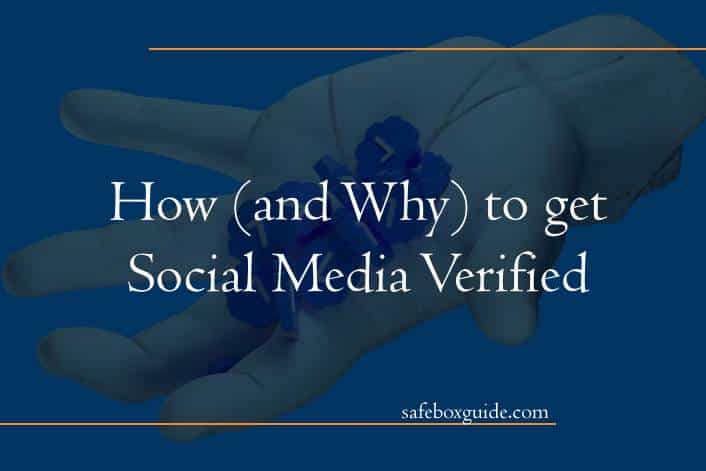In an era dominated by social media, where online presence can make or break careers and reputations, the coveted blue checkmark has become a symbol of credibility and authenticity. We’ve all come across those verified accounts on platforms like Twitter and Instagram, wondering how they earned that elusive validation. Whether you’re a business owner looking to build trust with your audience or an aspiring influencer seeking to establish yourself as an industry expert, getting social media verified is not only a status symbol but also comes with numerous benefits. In this article, we will delve into the world of social media verification – how it works, why it matters, and most importantly, how you can attain that sought-after tick mark next to your name.
Contents
Why Social Media Verification Matters
In today’s digital world, social media has become a powerful tool for communication and information sharing. However, with the rise of fake news and online scams, ensuring the authenticity of online profiles has become crucial. This is where social media verification comes into play. By verifying an account, platforms can verify that the user behind it is who they claim to be, providing a layer of trustworthiness and credibility to their content.
One important reason why social media verification matters is its impact on combating misinformation. In recent years, we’ve seen how false information spreads like wildfire across various platforms. By verifying accounts, social media networks can differentiate between authentic sources and imposters seeking to manipulate or deceive others. This not only protects users from consuming misleading content but also prevents reputational damage for individuals or companies whose profiles are targeted by impersonators.
Furthermore, social media verification serves as a powerful way to build trust between users and influencers or businesses. Verified accounts symbolize reliability and professionalism in the digital space. By displaying a blue badge or checkmark beside their name, verified users enjoy increased credibility among their followers and potential customers alike. This enhances engagement rates as people tend to place more faith in verified accounts and perceive them as leading voices in their respective fields.
In conclusion, social media verification plays a vital role in maintaining the integrity of online platforms amidst an onslaught of fake profiles and fabricated news stories. It acts as armor against deceptive practices while establishing transparency with audiences.

What is Social Media Verification?
Social media verification has become a crucial tool in today’s digital landscape. It not only helps individuals and businesses establish authenticity, but also safeguards against identity theft and impersonation. Social media platforms like Twitter, Instagram, and Facebook offer verification badges or checkmarks to distinguish real accounts from fake ones.
Verification goes beyond the mere blue tick or checkmark; it signifies that an account is legitimate and of public interest. It acts as a stamp of credibility, enhancing trust among followers and potential customers. This verification process involves submitting proof of identity or meeting certain criteria set by each platform. While the requirements may vary, the common goal is to prevent misinformation and create a verified community where users can rely on accurate information.
Companies are increasingly recognizing the importance of social media verification for their brand reputation. A verified account ensures that their messages reach the intended audience without being overshadowed by fraudulent accounts posing as theirs. Additionally, celebrities and public figures greatly benefit from verification as it protects them from imposters attempting to exploit their name and image for personal gain.
In conclusion, social media verification serves as a necessary safeguard promoting transparency in our online interactions. By verifying accounts on popular platforms, we can verify identities, protect brands from impersonation, and establish trust within our digital communities. Whether you’re an individual looking to grow your influence or a business striving for credibility amidst a vast sea of online noise – social media verification is indeed a powerful tool that shouldn’t be overlooked.
The Benefits of Being Verified
Being verified on social media platforms such as Instagram, Twitter, or Facebook comes with several noteworthy benefits. First and foremost, verification adds a layer of credibility to your online presence. It acts as a stamp of approval that shows users you are the authentic version of yourself or your brand. This can help build trust with your audience and establish you as a reputable source in your industry.
Moreover, having a verified account provides enhanced visibility and exposure. Verified accounts often receive higher priority in search results and may even be featured on the platform’s explore page or suggested accounts section. This increased visibility can lead to more followers, engagement, and ultimately expand your reach to wider audiences.
Another significant advantage is access to exclusive features made available only for verified users. For instance, on Twitter, verified accounts have the option to filter their notifications by categories like mentions from other verified users or followers they follow back. This allows them to manage their interactions more efficiently and focus on meaningful engagements.
In conclusion, obtaining verification status on social media platforms offers numerous advantages that go beyond mere appearances. From establishing credibility and increasing visibility to accessing exclusive features – being verified serves as an invaluable tool for building an influential online presence that sets you apart from others in the crowded digital landscape.

How to Get Verified on Different Platforms
For many users, getting verified on social media platforms is a badge of honor that brings validation and credibility to their online presence. However, the process can seem elusive and mysterious. Each platform has its own criteria for verification, but there are some common tips that can increase your chances across the board.
Firstly, it’s essential to build an authentic and engaged following. Platforms like Instagram and Twitter prioritize accounts with a significant number of followers who actively interact with your content. Additionally, you should establish yourself as an expert or influencer in your field because platforms tend to verify individuals who are well-known or have a significant impact on their industry.
Furthermore, maintaining a consistent brand presence is crucial for verification. This means having an official website or blog featuring biographical information about yourself or your company. Providing accurate contact details also shows professionalism and accessibility in case platforms need to verify your identity.
Overall, while getting verified may seem challenging at first glance, implementing these strategies will help you stand out from the crowd and increase your chances of obtaining that coveted blue tick on various social media platforms.
Tips and Best Practices for Verification
Verified badges on social media platforms have become like digital status symbols, signifying authenticity and credibility. But how does one actually go about getting verified? Here are some tips and best practices to help you navigate the verification process.
Firstly, it’s crucial to ensure that your account meets the basic eligibility requirements set by each platform. This typically includes being a public figure or having a significant online presence in categories such as media, sports, government, or entertainment. Additionally, having an established brand or business can also enhance your chances of getting verified. Remember that verification is not just about popularity – it should also reflect the unique value you bring to the platform and its users.
Secondly, it’s time to build up your online presence and establish a reputable personal brand. This means maintaining an active presence on relevant social media platforms and engaging with your audience regularly through meaningful content creation and genuine interactions. Creating high-quality content that resonates with your target audience not only helps grow your following but also demonstrates your expertise within your industry.
Lastly, take advantage of any connections or affiliations you may have that can vouch for your legitimacy online. Collaborating with well-established influencers or partnering with credible organizations can lend credibility to your profile when seeking verification. Additionally, optimizing keywords in bio sections and including professional links in the profile description can strengthen the case for verification.

Common Mistakes to Avoid
One of the most common mistakes people make when trying to get social media verified is approaching it as a one-time process. Getting verified is not just about filling out an application and waiting for approval; it requires consistent effort and engagement with your audience. Simply having a large number of followers or being famous does not guarantee verification either – you need to prove that your online presence is authentic, credible, and worthy of recognition.
Another mistake often made is focusing solely on follower count rather than building genuine connections with your audience. Having a high number of followers may seem impressive, but if they are inactive or not genuinely interested in your content, it will do little to enhance your chances of getting verified. Instead, focus on creating engaging and meaningful interactions with your followers by responding to comments, asking questions, and sharing valuable content that resonates with them.
Additionally, many people overlook the importance of maintaining consistency across all their social media platforms. From the name you use to the colors and logo you incorporate into your branding, everything should be cohesive across different platforms. Inconsistency can make it difficult for verification teams to recognize and verify you as a legitimate public figure or brand. Taking the time to ensure consistency in your online presence will significantly increase your chances of getting social media verified successfully.
Conclusion: The Importance of Social Media Verification
In conclusion, social media verification is of utmost importance in today’s digitally-driven world. With the rise in fake news and online fraud, it becomes crucial for individuals, businesses, and even governments to establish a sense of trust and credibility on these platforms.
Firstly, verified accounts act as a shield against impersonators and imposters. By verifying an account, social media platforms authenticate the identity of the individual or organization behind it, ensuring that users are interacting with genuine content. This verification process not only protects users from falling victim to scams or misinformation but also serves as a signal of legitimacy for brands and influencers looking to establish themselves in the digital sphere.
Secondly, social media verification is essential for maintaining the integrity of information across various platforms. Verified accounts often enjoy additional benefits such as access to better visibility features and algorithms that prioritize validated content. This ensures that verified sources are more likely to reach larger audiences, while minimizing the spread of misleading or false information.
In conclusion, obtaining social media verification is not just an optional badge for vanity purposes; it plays a vital role in building trust among users and safeguarding against online threats. It acts as a protective barrier against fake accounts while establishing authenticity in a sea of digital noise. Moreover, verifying accounts helps maintain the sanctity of information dissemination by ensuring reliable sources gain prominence on these platforms.

